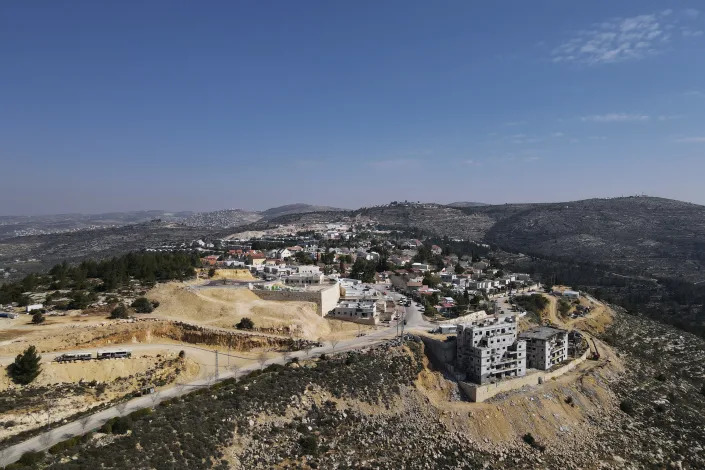Agence France-Presse
February 20, 2023

Biden ended the day back in Poland after another long train ride and was set to travel to Warsaw. (Evan Vucci / POOL/AFP)
President Joe Biden's surprise visit Monday morning to wartime Kyiv began in the dead of night at a military airport hangar outside Washington.
At 4:00 am (0900 GMT) Sunday -- unbeknown to the world's media, the Washington political establishment or American voters -- the 80-year-old Democrat boarded an Air Force Boeing 757, known as a C-32.
The plane, a smaller version of the one US presidents normally use on international trips, was parked well away from where Biden would usually board. And a telling detail: the shade on every window had been pulled down.
Fifteen minutes later, Biden, a handful of security personnel, a small medical team, close advisors, and two journalists who had been sworn to secrecy, took off en route to a war zone.
The US president is perhaps the most constantly scrutinized person on the planet.
Members of the press follow Biden wherever he goes -- whether to church or international summits. Every word he says in public is recorded, transcribed and published.
In this case, though, the usual pool of reporters, which for foreign trips would compromise 13 journalists from radio, TV, photo and written press organizations, was cut to one photographer and one writer.
The reporter, Sabrina Siddiqui from The Wall Street Journal, revealed -- once allowed by the White House to publish details -- that she and the photographer were summoned to Joint Base Andrews outside Washington at 2:15 am.
Their phones were confiscated -- not to be returned until Biden finally arrived in the Ukrainian capital about 24 hours later.
They flew for about seven hours from Washington to the US military base in Ramstein, Germany, for refueling. Here too, the window shades stayed down and they did not leave the plane.
The next flight was to Poland, landing in Rzeszow–Jasionka Airport. This may be a Polish airport, but since the Ukraine war it has also become an international hub for the US-led effort to arm the Ukrainians, funneling billions of dollars of weaponry and ammunition.
'Good to be back'
Up to this point, Siddiqui and the photographer, the Associated Press' Evan Vucci, had not seen Biden himself. That didn't change at the airport or when they got into a motorcade of SUVs.
Reporters traveling with Biden often go in motorcades, but something was very different about this one: no sirens or anything else to announce that the US president was headed to Przemysl Glowny -- the Polish train station near the Ukrainian border.
It was already 9:15 pm local time as they pulled up at a train. The journalists were told to board, still without laying eyes on Biden.
Running a route that has brought untold quantities of aid into Ukraine and untold numbers of Ukrainian civilians fleeing the other way, the train had about eight cars. Most of the people aboard, Siddiqui said, were "heavy security."
Biden is an avowed train buff.
He loves recounting his years of commuting by rail between Washington and home in Delaware when he was a senator, bringing up two young sons after their mother died in a car accident. One of his nicknames is "Amtrak Joe."
This 10-hour trip into Ukraine, though, was unlike any taken by a modern US president -- journeying into an active war zone where, unlike presidential visits to Afghanistan or Iraq, US troops are not the ones providing security.
The train rolled into Kyiv with the rising sun.
Biden, who had last visited the Ukrainian capital when he was vice president under Barack Obama disembarked at about 8:07 am.
"It's good to be back in Kyiv," he said.
Sneaking a president from DC to Kyiv without anyone noticing


President Joe Biden, right, and Ukrainian President Volodymyr Zelenskyy hug as they say goodbye at the Memorial Wall of Fallen Defenders of Ukraine in Russian-Ukrainian War, in Kyiv, Ukraine, Monday, Feb. 20, 2023. (Ukrainian Presidential Press Office via AP)
EVAN VUCCI, JOHN LEICESTER and ZEKE MILLER
Mon, February 20, 2023
KYIV, Ukraine (AP) — President Joe Biden’s motorcade slipped out of the White House around 3:30 a.m. Sunday. No big, flashy Air Force One for this trip -– the president vanished into the darkness on an Air Force C-32, a modified Boeing 757 normally used for domestic trips to smaller airports.
The next time he turned up — 20 hours later — it was in downtown Kyiv, Ukraine.
Biden’s surprise 23-hour visit to Ukraine on Monday was the first time in modern history that a U.S. leader visited a warzone outside the aegis of the U.S. military — a feat the White House said carried some risk even though Moscow was given a heads-up.
Over the next five hours, the president made multiple stops around town — ferried about in a white SUV rather than the presidential limousine — without any announcement to the Ukrainian public that he was there. But all that activity attracted enough attention that word of his presence leaked out well before he could get back to Poland, which was the original plan. Aides at the White House were surprised the secret held as long as it did.
But Russia knew what the Ukrainian public did not. U.S. officials had given Moscow notice of Biden's trip.
The president had been itching since last year to join the parade of other Western officials who have visited Kyiv to pledge support standing shoulder to shoulder with Ukrainian President Volodymyr Zelenskyy in the capital.
Biden's planned trip to Warsaw, Poland, and the Presidents' Day holiday provided an obvious opening to tack on a stop in Kyiv. A small group of senior officials at the White House and across U.S. national security agencies set about working in secret for months to make it happen, national security adviser Jake Sullivan said Monday. Biden only gave the final sign-off Friday.
Sullivan said the trip “required a security, operational, and logistical effort from professionals across the U.S. government to take what was an inherently risky undertaking and make it a manageable risk.”
Once Biden was secreted aboard the Air Force jet, the call sign “SAM060,” for Special Air Mission, was used for the plane instead of the usual “Air Force One.” It was parked in the dark with the window-shades down, and took off from Joint Base Andrews at 4:15 a.m. Eastern time.
After a refueling stop in Germany, where the president was kept aboard the aircraft, Biden’s plane switched off its transponder for the roughly hour-long flight to Rzeszow, Poland, the airport that has served as the gateway for billions of dollars in Western arms and VIP visitors into Ukraine. From there, he boarded a train for the roughly 10-hour overnight trip to Kyiv.
He arrived in the capital at 8 a.m. Monday, was greeted by Ambassador Bridget Brink and entered his motorcade for the drive to Mariinsky Palace. Even while he was on the ground in Ukraine, flights transporting military equipment and other goods were continuing unabated to Rzeszow from Western cities.
Meanwhile, in Kyiv, many main streets and central blocks were cordoned off without explanation. People started sharing videos of long motorcades of cars speeding along streets where access was restricted — the first clues that Biden had arrived.
Biden traveled with a far smaller than usual retinue: Sullivan, deputy chief of staff Jen O’Malley Dillon and the director of Oval Office operations, Annie Tomasini. They were joined by his Secret Service detail, the military aide carrying the so-called “nuclear football,” a small medical team and the official White House photographer.
Only two journalists were on board instead of the usual complement of 13. Their electronic devices were powered off and turned over to the White House for the duration of the trip into Ukraine. A small number of journalists based in Ukraine were summoned to a downtown hotel on Monday morning to join them, not informed that Biden was visiting until shortly before his arrival.
Even with Western surface-to-air missile systems bolstering Ukraine’s defenses, it was rare for a U.S. leader to travel to a conflict zone where the U.S. or its allies did not have control over the airspace.
The U.S. military does not have a presence in Ukraine other than a small detachment of Marines guarding the embassy in Kyiv, making Biden’s visit more complicated than visits by prior U.S. leaders to war zones.
“We did notify the Russians that President Biden will be traveling to Kyiv,” Sullivan told reporters. “We did so some hours before his departure for deconfliction purposes.” He declined to specify the exact message or to whom it was delivered but said the heads-up was to avoid any miscalculation that could bring the two nuclear-armed nations into direct conflict.
While Biden was in Kyiv, U.S. surveillance planes, including E-3 Sentry airborne radar and an electronic RC-135W Rivet Joint aircraft, were keeping watch over Kyiv from Polish airspace.
The sealing off of Kyiv roads that are usually humming with traffic brought an eerie calm to the center of the capital. It was so quiet that crows could be heard cawing as Biden and Zelenskyy walked from their motorcade to the gold-domed St. Michael’s Cathedral under skies as blue as the outer walls of the cathedral itself.
“Let’s walk in and take a look,” Biden said, wearing his trademark aviator sunglasses against the glare. The presidents disappeared inside as heavily armed soldiers stood guard outside.
Cathedral bells chirped at the stroke of 11:30 a.m. followed shortly by air raid alarms, at 11:34 a.m., just before the men reemerged. The sirens were first a distant howl rising over the city, followed seconds later by alarms from mobile phone apps wailing from people’s pockets.
Those alarms are voiced by “Star Wars” actor Mark Hamill, and his Luke Skywalker voice urged people to take cover, warning: “Don’t be careless. Your overconfidence is your weakness.”
The two leaders walked at a measured pace with no outward signs of concern through the cathedral's arched front gate onto the square in front, where the rusting hulks of destroyed Russian tanks and other armored vehicles have been stationed as grim reminders of the war.
When the square isn’t blocked off, as it was during the leaders’ visit, people come to look at the vehicles, many taking selfies.
Biden appeared to pay the hulks no mind as he and Zelenskyy followed behind honor guards carrying two wreaths to the wall of remembrance honoring Ukrainian soldiers killed since 2014, the year Russia annexed Ukraine’s Crimean peninsula and Russian-backed fighting erupted in eastern Ukraine.
It was only then that the first images of Biden in the capital popped up on Ukrainian social media and the secret visit became global news.
“He is like an example of a president who is not afraid to show up in Ukraine and to support us,” said Kyiv resident Myroslava Renova, 23, after Biden’s visit became known.
Biden headed to the U.S. Embassy for a brief stop before departing the country by train back to Poland aboard a well-appointed, wood-paneled train car with tightly drawn curtains, a dining table and a leather sofa.
The all-clear notice, also voiced by Hamill, sounded at 1:07 p.m., as Biden's train was pulling away from the station.
“The air alert is over," Hamill said. “May the force be with you.”
___
Associated Press photographer Evan Vucci reported from aboard Biden's aircraft and in Kyiv. Miller reported from Washington. Associated Press writers Aamer Madhani in Washington and Nicolae Dumitrache in Kyiv contributed.

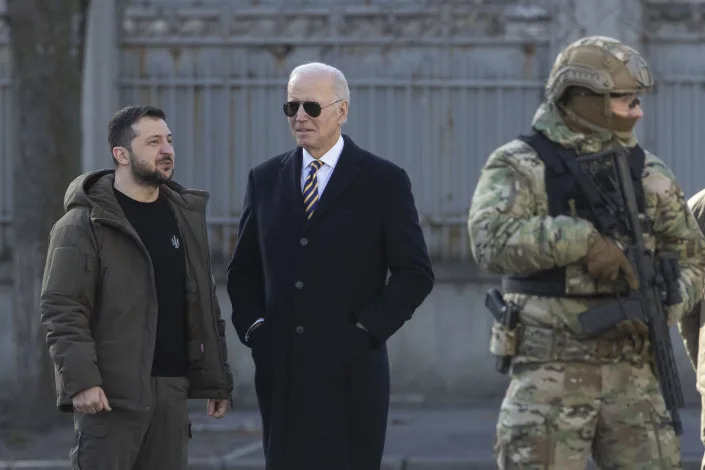

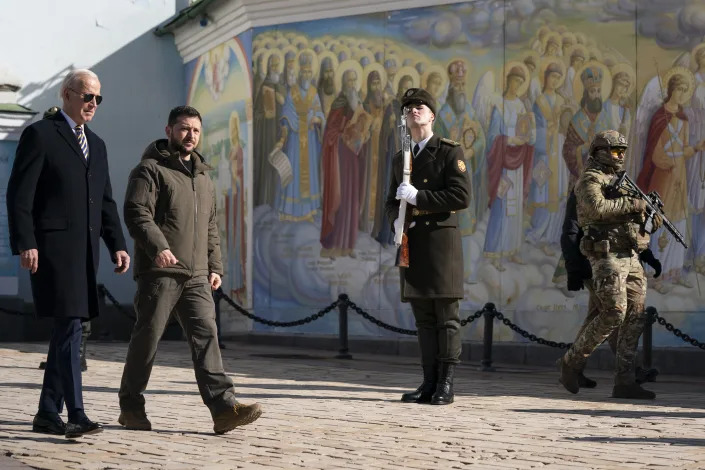




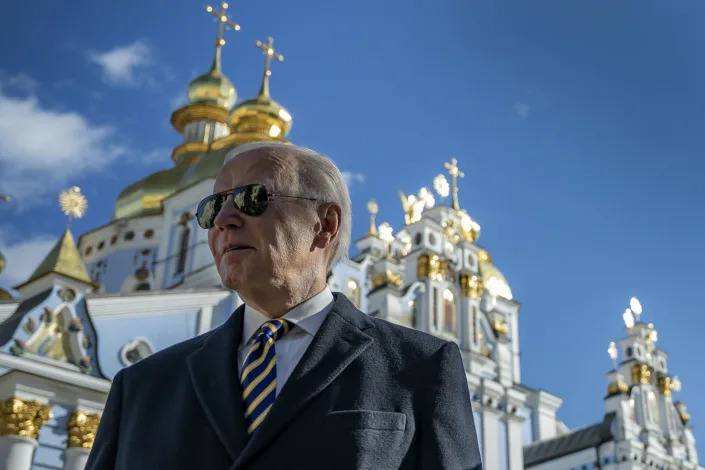





President Joe Biden, right, and Ukrainian President Volodymyr Zelenskyy hug as they say goodbye at the Memorial Wall of Fallen Defenders of Ukraine in Russian-Ukrainian War, in Kyiv, Ukraine, Monday, Feb. 20, 2023. (Ukrainian Presidential Press Office via AP)
EVAN VUCCI, JOHN LEICESTER and ZEKE MILLER
Mon, February 20, 2023
KYIV, Ukraine (AP) — President Joe Biden’s motorcade slipped out of the White House around 3:30 a.m. Sunday. No big, flashy Air Force One for this trip -– the president vanished into the darkness on an Air Force C-32, a modified Boeing 757 normally used for domestic trips to smaller airports.
The next time he turned up — 20 hours later — it was in downtown Kyiv, Ukraine.
Biden’s surprise 23-hour visit to Ukraine on Monday was the first time in modern history that a U.S. leader visited a warzone outside the aegis of the U.S. military — a feat the White House said carried some risk even though Moscow was given a heads-up.
Over the next five hours, the president made multiple stops around town — ferried about in a white SUV rather than the presidential limousine — without any announcement to the Ukrainian public that he was there. But all that activity attracted enough attention that word of his presence leaked out well before he could get back to Poland, which was the original plan. Aides at the White House were surprised the secret held as long as it did.
But Russia knew what the Ukrainian public did not. U.S. officials had given Moscow notice of Biden's trip.
The president had been itching since last year to join the parade of other Western officials who have visited Kyiv to pledge support standing shoulder to shoulder with Ukrainian President Volodymyr Zelenskyy in the capital.
Biden's planned trip to Warsaw, Poland, and the Presidents' Day holiday provided an obvious opening to tack on a stop in Kyiv. A small group of senior officials at the White House and across U.S. national security agencies set about working in secret for months to make it happen, national security adviser Jake Sullivan said Monday. Biden only gave the final sign-off Friday.
Sullivan said the trip “required a security, operational, and logistical effort from professionals across the U.S. government to take what was an inherently risky undertaking and make it a manageable risk.”
Once Biden was secreted aboard the Air Force jet, the call sign “SAM060,” for Special Air Mission, was used for the plane instead of the usual “Air Force One.” It was parked in the dark with the window-shades down, and took off from Joint Base Andrews at 4:15 a.m. Eastern time.
After a refueling stop in Germany, where the president was kept aboard the aircraft, Biden’s plane switched off its transponder for the roughly hour-long flight to Rzeszow, Poland, the airport that has served as the gateway for billions of dollars in Western arms and VIP visitors into Ukraine. From there, he boarded a train for the roughly 10-hour overnight trip to Kyiv.
He arrived in the capital at 8 a.m. Monday, was greeted by Ambassador Bridget Brink and entered his motorcade for the drive to Mariinsky Palace. Even while he was on the ground in Ukraine, flights transporting military equipment and other goods were continuing unabated to Rzeszow from Western cities.
Meanwhile, in Kyiv, many main streets and central blocks were cordoned off without explanation. People started sharing videos of long motorcades of cars speeding along streets where access was restricted — the first clues that Biden had arrived.
Biden traveled with a far smaller than usual retinue: Sullivan, deputy chief of staff Jen O’Malley Dillon and the director of Oval Office operations, Annie Tomasini. They were joined by his Secret Service detail, the military aide carrying the so-called “nuclear football,” a small medical team and the official White House photographer.
Only two journalists were on board instead of the usual complement of 13. Their electronic devices were powered off and turned over to the White House for the duration of the trip into Ukraine. A small number of journalists based in Ukraine were summoned to a downtown hotel on Monday morning to join them, not informed that Biden was visiting until shortly before his arrival.
Even with Western surface-to-air missile systems bolstering Ukraine’s defenses, it was rare for a U.S. leader to travel to a conflict zone where the U.S. or its allies did not have control over the airspace.
The U.S. military does not have a presence in Ukraine other than a small detachment of Marines guarding the embassy in Kyiv, making Biden’s visit more complicated than visits by prior U.S. leaders to war zones.
“We did notify the Russians that President Biden will be traveling to Kyiv,” Sullivan told reporters. “We did so some hours before his departure for deconfliction purposes.” He declined to specify the exact message or to whom it was delivered but said the heads-up was to avoid any miscalculation that could bring the two nuclear-armed nations into direct conflict.
While Biden was in Kyiv, U.S. surveillance planes, including E-3 Sentry airborne radar and an electronic RC-135W Rivet Joint aircraft, were keeping watch over Kyiv from Polish airspace.
The sealing off of Kyiv roads that are usually humming with traffic brought an eerie calm to the center of the capital. It was so quiet that crows could be heard cawing as Biden and Zelenskyy walked from their motorcade to the gold-domed St. Michael’s Cathedral under skies as blue as the outer walls of the cathedral itself.
“Let’s walk in and take a look,” Biden said, wearing his trademark aviator sunglasses against the glare. The presidents disappeared inside as heavily armed soldiers stood guard outside.
Cathedral bells chirped at the stroke of 11:30 a.m. followed shortly by air raid alarms, at 11:34 a.m., just before the men reemerged. The sirens were first a distant howl rising over the city, followed seconds later by alarms from mobile phone apps wailing from people’s pockets.
Those alarms are voiced by “Star Wars” actor Mark Hamill, and his Luke Skywalker voice urged people to take cover, warning: “Don’t be careless. Your overconfidence is your weakness.”
The two leaders walked at a measured pace with no outward signs of concern through the cathedral's arched front gate onto the square in front, where the rusting hulks of destroyed Russian tanks and other armored vehicles have been stationed as grim reminders of the war.
When the square isn’t blocked off, as it was during the leaders’ visit, people come to look at the vehicles, many taking selfies.
Biden appeared to pay the hulks no mind as he and Zelenskyy followed behind honor guards carrying two wreaths to the wall of remembrance honoring Ukrainian soldiers killed since 2014, the year Russia annexed Ukraine’s Crimean peninsula and Russian-backed fighting erupted in eastern Ukraine.
It was only then that the first images of Biden in the capital popped up on Ukrainian social media and the secret visit became global news.
“He is like an example of a president who is not afraid to show up in Ukraine and to support us,” said Kyiv resident Myroslava Renova, 23, after Biden’s visit became known.
Biden headed to the U.S. Embassy for a brief stop before departing the country by train back to Poland aboard a well-appointed, wood-paneled train car with tightly drawn curtains, a dining table and a leather sofa.
The all-clear notice, also voiced by Hamill, sounded at 1:07 p.m., as Biden's train was pulling away from the station.
“The air alert is over," Hamill said. “May the force be with you.”
___
Associated Press photographer Evan Vucci reported from aboard Biden's aircraft and in Kyiv. Miller reported from Washington. Associated Press writers Aamer Madhani in Washington and Nicolae Dumitrache in Kyiv contributed.















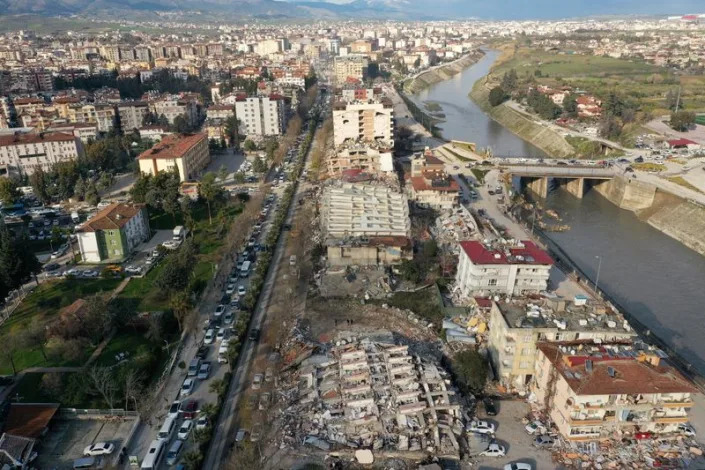







 A worker watches the digger as he stands on the rubble from destroyed buildings as she awaits the body of her relatives on Feb. 20, 2023 in Hatay, Turkey.Getty Images
A worker watches the digger as he stands on the rubble from destroyed buildings as she awaits the body of her relatives on Feb. 20, 2023 in Hatay, Turkey.Getty Images A man walks in front of rubble from destroyed buildings on Feb. 20, 2023 in Hatay, Turkey.Getty Images
A man walks in front of rubble from destroyed buildings on Feb. 20, 2023 in Hatay, Turkey.Getty Images A man holds his mobile phone near destroyed structures from a car in the aftermath of the deadly earthquake in Antakya, Hatay province, Turkey, on Feb. 20, 2023.REUTERS
A man holds his mobile phone near destroyed structures from a car in the aftermath of the deadly earthquake in Antakya, Hatay province, Turkey, on Feb. 20, 2023.REUTERS

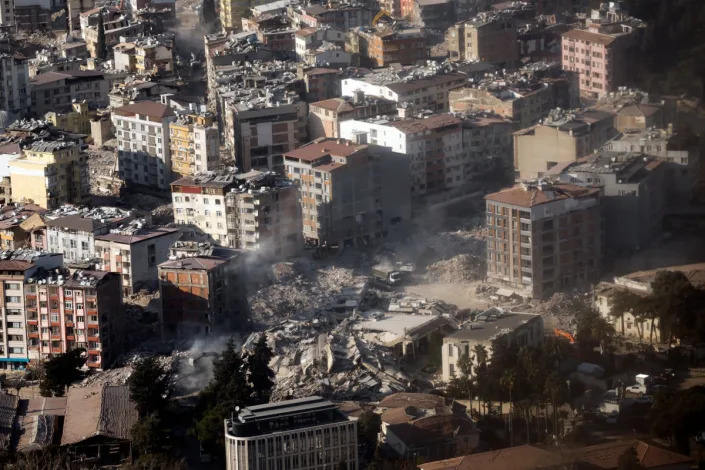
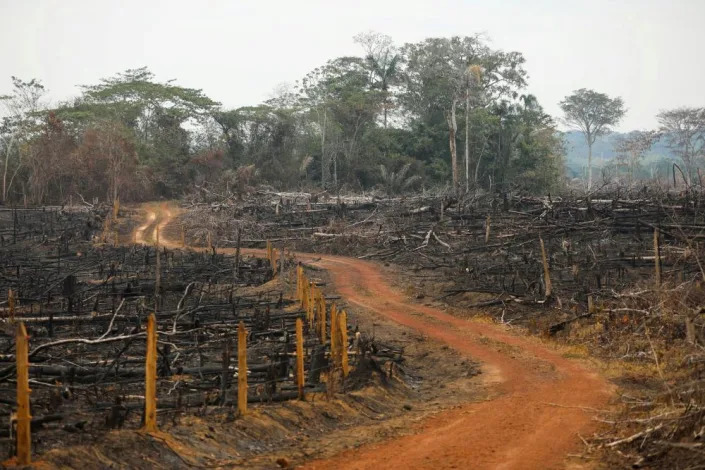




.png)
